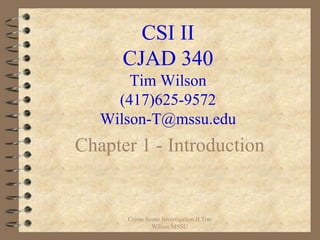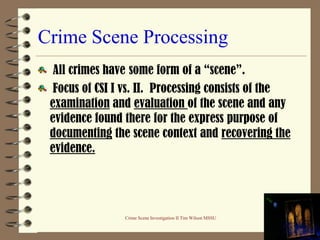Chapter 1 - Tim Wilson
- 1. CSI II CJAD 340 Tim Wilson (417)625-9572 Wilson-T@mssu.edu Chapter 1 - Introduction Crime Scene Investigation II Tim Wilson MSSU
- 2. Crime Scene Processing All crimes have some form of a âsceneâ. Focus of CSI I vs. II. Processing consists of the examination and evaluation of the scene and any evidence found there for the express purpose of documenting the scene context and recovering the evidence. Crime Scene Investigation II Tim Wilson MSSU
- 3. Crime Scene Investigation and Police Objectives Two major objectives of the CSI Crime repression: When crime prevention fails, the police seek to repress the criminal by actively investigating crime and bringing the criminal to justice. Protection of personal liberty. They do this in a manner that ensures their methods and practices abide by the constitution and the law. Crime Scene Investigation II Tim Wilson MSSU
- 4. Evidence Defined From CSI I- Any material that may aid in determining the truth during an investigation. Physical Evidence Can Prove: There are two basic forms in which evidence comes to the investigation. They are: Testimonial evidence: admissions, confessions and statements by parties involved in the investigation. Physical evidence: tangible objects that are collected and or documented. Crime Scene Investigation II Tim Wilson MSSU
- 5. Testimonial vs. Physical Both forms of evidence are important and neither can be excluded. Crime Scene Investigation II Tim Wilson MSSU
- 6. Testimonial Evidence Testimonial evidence comes from people and as such is subject to alteration. People may: Purposefully lie to investigators or the court. Misperceive events and report those misperceptions. Unknowingly fill in the blanks in their perceptions Remember the little magic trick in CSI I? Testimonial evidence is always taken with a grain of salt. It is known that even the most well intentioned witness will not be 100% accurate Crime Scene Investigation II Tim Wilson MSSU
- 7. Physical Evidence Physical evidence is real and tangible, we can put our hands on it or we can see it (sometime with mechanical aid) Physical evidence will never lie. We can misinterpret it or be misled by it, but that is a human factor and not associated to the evidence itself. Crime Scene Investigation II Tim Wilson MSSU
- 8. The Jigsaw Puzzle Analogy Physical evidence can be likened to pieces of a jigsaw puzzle. Having the pieces means little, until we can put them back in order. This means recognizing the context of the evidence. Looking at the Box Crime Scene Investigation II Tim Wilson MSSU
- 9. Defining an Objective Picture of the Event By evaluating the context of evidence we may be able to put the pieces in order and gain an understanding of how they came to be there. The goal of crime scene investigation is under- standing the evidence, not simply collecting it. Crime Scene Investigation II Tim Wilson MSSU








